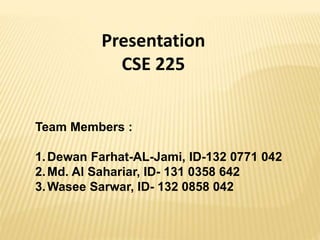
Splay tree C++
- 1. Presentation CSE 225 Team Members : 1.Dewan Farhat-AL-Jami, ID-132 0771 042 2.Md. Al Sahariar, ID- 131 0358 642 3.Wasee Sarwar, ID- 132 0858 042
- 2. Splay Tree
- 3. What is Splay Tree? Splay trees are self-adjusting binary search trees. A node in a Binary_Search_Tree is "splayed" when it is moved to the root of the tree by one or more "rotations". Whenever a node is accessed (Find, Insert, Remove, etc.), it is splayed, thereby making it the root. In addition to moving the accessed node to the root, the height of the tree may be shortened.
- 4. Splay tree Rules Zig: Rotate the node about its parent (left or right). Zig_Zig: Rotate the parent about the grandparent (left or right), then rotate the node about its parent in the same direction. Zig_Zag: Rotate the node about its parent (left or right), then rotate the node about its grandparent in the other direction.
- 5. Zig (Rotate Right): splay* RR_Rotate(splay* k2) { splay* k1 = k2->lchild; k2->lchild = k1->rchild; k1->rchild = k2; return k1; }
- 6. Zig (Rotate Left): splay* LL_Rotate(splay* k2) { splay* k1 = k2->rchild; k2->rchild = k1->lchild; k1->lchild = k2; return k1; }
- 7. Functions: Insert Delete Search
- 8. Inser t
- 9. Insert (5) 5
- 10. Insert (10) 5 10
- 11. Insert (10) 5 10 It will move to the ROOT
- 12. Insert (10) 10 5 5 is less than 10 and moved to left Now 10 is the ROOT
- 13. Insert (15) 10 5 15
- 14. Insert (15) 10 5 15 Now 15 will move to the ROOT
- 15. Insert (15) 15 10 5 10 is less than 15 and moved to left 5 is less than 10 and moved to left
- 16. Insert (12) 15 10 5 12
- 17. Insert (12) 15 10 5 12 Now 12 will move to the place of 10
- 18. Insert (12) 15 12 10 5 12 moved to the place of 10 10 is less than 12 and moved to left
- 19. Insert (12) 15 12 10 5 12 will move to the ROOT
- 20. Insert (12) 12 10 5 15 15 is greater than 12 and moved to the right
- 21. Insert Implementation : splay* Insert(int key, splay* root) { static splay* p_node = NULL; if (!p_node) p_node = New_Node(key); else p_node->key = key; if (!root) { root = p_node; p_node = NULL; return root; } root = Splay(key, root);
- 22. if (key < root->key) { p_node->lchild = root->lchild; p_node->rchild = root; root->lchild = NULL; root = p_node; } else if (key > root->key) { p_node->rchild = root->rchild; p_node->lchild = root; root->rchild = NULL; root = p_node; } else return root; p_node = NULL; return root; }
- 23. Delet e
- 24. Delete (4) from an existing tree 6 1 9 4 7 2
- 25. Delete (4) from an existing tree 6 1 9 4 7 2 Now 4 is going to be the ROOT
- 26. Delete (4) from an existing tree 4 4 is the root now 1 6 2 7 9
- 27. Delete (4) from an existing tree 4 has been Deleted and the tree has splited into 2 parts 1 6 2 7 9
- 28. Delete (4) from an existing tree 2 1 6 As (2) is the largest 9 element of the left sub tree, it will become the ROOT. 7
- 29. Delete function Implementation: splay* Delete(int key, splay* root) { splay* temp; if (!root) return NULL; root = Splay(key, root); if (key != root->key) return root;
- 30. else { if (!root->lchild) { temp = root; root = root->rchild; } else { temp = root; root = Splay(key, root->lchild); root->rchild = temp->rchild; } free(temp); return root; } }
- 31. Search
- 32. Find (10) 12 10 5 15
- 33. Find (10) 12 10 5 15 10 will move to the ROOT
- 34. Find (10) 10 5 10 is FOUND as it is the ROOT now ! 15 12 12 is greater than 10 and moved to right
- 35. Zig-Zig 1 2 3 4 5 6 1 2 3 6 5 4 Find (6)
- 36. 1 2 3 6 5 4 1 6 3 2 5 4 Find (6) zig-zig
- 37. 1 6 3 2 5 4 6 1 3 2 5 4 Find (6) Zig
- 38. Search function Implementation: splay* Search(int key, splay* root) { return Splay(key, root); }
- 39. Splay function implementation: splay* Splay(int key, splay* root) { if (!root) return NULL; splay header; header.lchild = header.rchild = NULL; splay* LeftTreeMax = &header; splay* RightTreeMin = &header; while (1) { if (key < root->key) { if (!root->lchild) break; if (key < root->lchild->key) { root = RR_Rotate(root); if (!root->lchild) break; }
- 40. RightTreeMin->lchild = root; RightTreeMin = RightTreeMin->lchild; root = root->lchild; RightTreeMin->lchild = NULL; } else if (key > root->key) { if (!root->rchild) break; if (key > root->rchild->key) { root = LL_Rotate(root); if (!root->rchild) break; } LeftTreeMax->rchild = root; LeftTreeMax = LeftTreeMax->rchild; root = root->rchild; LeftTreeMax->rchild = NULL; }
- 41. else break; } LeftTreeMax->rchild = root->lchild; RightTreeMin->lchild = root->rchild; root->lchild = header.rchild; root->rchild = header.lchild; return root; }
- 42. SPLAY TREE TIME COMPLEXITY Sorted List Search Insertion Deletion with arrays O(log n) O(n) O(n) with linked list O(n) O(n) O(n) With Splay trees O(log n) O(log n) O(log n)
- 43. Splay Tree Usage Memory allocators Routers Garbage collectors Data compression
- 44. Advantage : Simple Implementation Comparable performance Small memory footprint Working well with nodes containing identical keys Disadvantage: Height can be linear Extra management is needed if multiple threads are allowed to perform FIND operations. Splay tree can be worse than Static tree.
- 45. Thank You !
